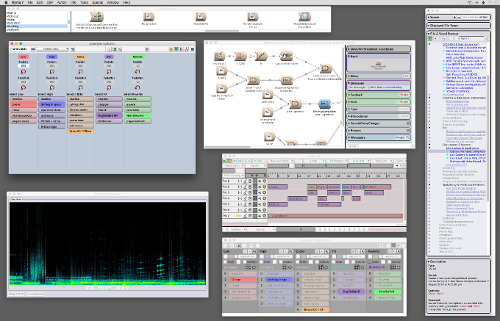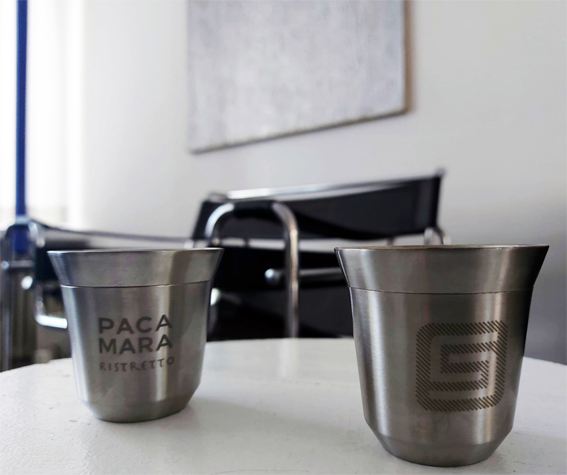" I
learn by stacking frequen cies into new forms - I
create" - Roland Kuit
This Restretto
makes you wired. Meet the new PACAMARA
VIDEO
Research, composition
and sonic art on Kyma
7
\ Pacarana \ Pacamara :
"Because it is not only a sound device, but with a time line as well, you can
integrate multiple references into a complexly woven composers fabric. y
ways. Granular, phase de-correlation, nonlinear distortion, recursive filtering,
convolution. phase-difference, resynthesis, Interaction, Time, Morphology,
Singularities. All on a time line."
From philosophy to
science to .................. sound
KYMA sonics in space on a NASA
mission
VIDEO
This sound research, music and sonic art has been sent into space by the
National Aeronautics and Space Administration (NASA). Integrated in the
OSIRIS-REx Mission on September 8, 2016. MISSION TO 101955 BENNU The first U.S.
mission to return samples from an asteroid to Earth, addressing multiple NASA
Solar System Exploration objectives. THE MISSION: The OSIRIS-REx Mission seeks
answers to questions that are central to the human experience: Where did we come
from? What is our destiny? OSIRIS-REx is going to Bennu, a carbon-rich asteroid
that records the earliest history of our Solar System, and will be bringing a
piece of it back to Earth. Bennu may contain the molecular precursors to the
origin of life and the Earth’s oceans. Bennu is also one of the most potentially
hazardous asteroids and has a relatively high probability of impacting the Earth
late in the 22nd century. OSIRIS-REx will determine Bennu’s physical and
chemical properties, which will be critical for future scientists to know when
developing an impact mitigation mission. OSIRIS-REx is scheduled to launch 8
September 2016 and travel to the asteroid Bennu. The
#WeTheExplorers
campaign invites the public to take part in this mission by expressing, through
art, how the mission’s spirit of exploration is reflected in their own lives.
Submitted works of art will be saved on a chip on the spacecraft. I would like
to express my deepest gratitude to the NASA for the extraordinary effort to be a
vessel of culture and making this possible. This is a very special honour! -
Roland Kuit Roland Kuit: Kyma Karin Schomaker: Cover art Thanks to NASA for
permission using NASA and OSIRIS-REx logo Atlas V sound by NASA. Processed by
Roland Kuit on KYMA. This is a non-commercial album. Download on request. IN
REMEMBRANCE OF MICHAEL J. DRAKE © 2016 Roland Emile Kuit Tests and experiments:VIDEO
VIDEO
Research sound/music/sonic art with the Symbolic Sound Kyma systems.
Sonic space - Installations:VIDEO VIDEO
A lecture on Time - phase - movement - spaceVIDEO
5th Tehran International Electronic Music Festival, Iran 2022 2022.02.19 -
2022.02.26 Organized by YARAVA Music Group, Department of Music of Tehran
University and Art University THE WELL Lecture by Roland Kuit Curated by Dimitri
Papageorgiou The RNA LAB Quartet When the COV-19 pandemic reached Europe, Roland
Kuit figured out how to create Viral genomes as molecular sonics. He created
sonic monument In memory of all victims who have died as a result of epidemics
worldwide. MONUMENTUM was premiered on RADIOARTE ITALIA during the VI Chigiana
International Festival & Summer Academy Siena, Italy 2020. Chaotic feedback
systems driving nano articulations as layers of sound to express a silenced
social and cultural life. This period must have changed us in how we think and
about what is important in life. Maybe we have lost relatives or friends.
Fortunately, the COV-19 virus is weakened and life has started to emerge again.
Roland took the forty created sonic pandemics as a new starting point to create
a molecular genome's quartet. With the multigrid in Kyma, algorithmic mutations
became possible by merging, morphing, adding and subtracting these genomes into
new variants. We notice in this lecture how Brownian noise and Lossy Integrators
create unpredictable and pseudo patterns in spectra, integrated in feedback
systems or layering by multiplication. Structures of Boolean Gates creating
thresholding stills of the amplitudes or spectra with an outcome is always
different. Like a virus is not predictable, advanced mutated spectral clusters
arise as a new beginning. The lecture The Well is how to create your own
creative well and the freedom how to extract works from it as an artist. Thanks
to: Karel Goeyvearts Dick Raaijmakers Gottfried Michael Koenig J.S. Bach Gerrit
Rietveld Herman de Vries City of Amsterdam
© Roland Emile Kuit 2022
Kyma™ is a registered trademark of Symbolic Sound Corporation
Copyright © 2012 - 2024 Roland Emile Kuit. Laboratory of Patching,
SoundLab,
SONIC SPACE All Rights Reserved.
Unauthorized duplication and distribution of copyrighted material
violates Federal Law.
This website collects no personal data. 






